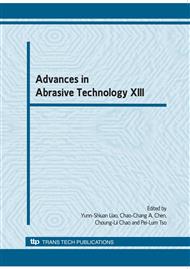p.849
p.855
p.861
p.867
p.873
p.879
p.885
p.891
p.899
Influence of the Electrochemical Dissolution Effect on the Material Removal Rate Utilizing Electrokinetic Phenomenon
Abstract:
Recently, material removal utilising electrokinetic phenomenon was proposed as an alternative to create material removal at the nanometric level [1]. The concept of the introduced material removal process is to impinge particles contained in the slurry, under the influence of hydrodynamic and electrokinetic effects, onto the workpiece with a predetermined velocity to create material removal on the surface. The material removal process proved to be feasible where the material removal rate was reported to be in the range of a few hundred nm/hr with a surface roughness of a few nm (RMS). This paper aims to look into the effect of the electrochemical dissolution on the material removal process since high voltages are involved during the material removal process. During the experimental study, electrochemical dissolution was observed and it contributed a certain proportion of the material removal process. However, the main material removal mechanism still relies on the mechanical action of the abrasive particles on the surface of the workpiece to create material removal during the process.
Info:
Periodical:
Pages:
873-878
Citation:
Online since:
August 2010
Authors:
Keywords:
Price:
Сopyright:
© 2010 Trans Tech Publications Ltd. All Rights Reserved
Share:
Citation:


